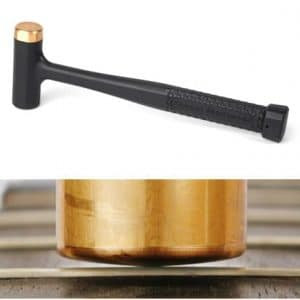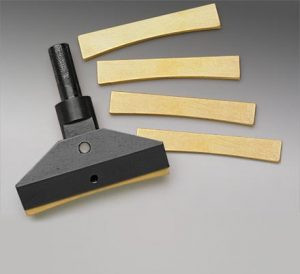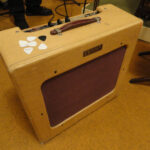For guitar builders and luthiers, achieving perfect fretwork is paramount. Guitar Frets are crucial for playability, intonation, and the overall feel of the instrument. One of the fundamental steps in crafting a guitar neck is installing the frets correctly. While there are various tools and techniques, the debate often comes down to two primary methods: using a fret hammer versus a fret press. Choosing the right approach can significantly impact the quality and efficiency of your fret installation. This article delves into the strengths and weaknesses of both the fret hammer and the fret press, helping you decide which tool, or combination of tools, best suits your guitar building needs and leads to superior guitar frets.
Understanding the Essentials of Guitar Fret Installation
Before diving into the specifics of fret hammers and presses, it’s crucial to understand the core objective of fret installation. The goal is to seat each guitar fret firmly and evenly into its designated slot on the fretboard. A properly installed fret should be seated deeply enough to ensure solid contact with the wood along its entire length, preventing any rocking or movement. This solid seating is essential for optimal sound transmission, accurate intonation, and comfortable playability. Furthermore, consistent fret height is vital for a smooth playing surface, eliminating buzzing and dead spots. Whether you opt for a hammer or a press, the underlying principle remains the same: achieving a tight, uniform, and stable fret installation that contributes to the overall quality and longevity of the guitar.
Hammer Fretting: The Traditional Approach
 Luthier using a dead blow hammer to install guitar frets
Luthier using a dead blow hammer to install guitar frets
The hammer method is often considered the more traditional approach to guitar fret installation. Many luthiers, especially those starting out, find themselves initially drawn to using a hammer due to its simplicity and lower initial cost. The basic principle is straightforward: the fret is positioned over the slot, and then gently hammered into place. However, achieving consistently excellent results with a hammer requires developing a feel for the right amount of force and technique. While seemingly simple, mastering hammer fretting involves understanding how to avoid damaging the fret wire and ensuring even seating across the fretboard.
Pros of Hammer Fretting
- Cost-Effective Entry: The primary advantage of hammer fretting is the lower initial investment. A basic dead-blow hammer suitable for fretwork is relatively inexpensive compared to a fret press setup. This makes it an accessible entry point for beginners or those on a tight budget.
- Versatility and Accessibility: A hammer is highly versatile and can be used in various situations. It’s particularly useful for refretting jobs or working on finished necks where maneuvering a larger press might be cumbersome. Its portability also makes it convenient for on-the-go repairs or adjustments.
- Tactile Feedback: For experienced luthiers, hammer fretting provides direct tactile feedback. They can feel the fret seating into the slot, allowing for subtle adjustments in force and technique as needed. This can be advantageous for nuanced fretwork.
Cons of Hammer Fretting
- Technique Sensitivity: The biggest challenge with hammer fretting is consistency. It requires a refined technique to avoid uneven seating, fret end lift, or damage to the fret wire. Inconsistent hammer blows can lead to variations in fret height and seating depth, potentially affecting playability and intonation.
- Potential for Fret End Spring-Up: One common issue with hammer fretting, especially for beginners, is the tendency for fret ends to spring up after installation. This occurs when the force of the hammer blow isn’t directed perfectly, causing the fret ends to lift slightly out of the slot. Addressing this requires additional work and can be time-consuming.
- Noise and Vibration: Hammering, by its nature, is a noisy process. The repeated striking of metal on metal can be loud and potentially disruptive in a shared workspace. Furthermore, the vibrations from hammering can be transmitted through the guitar neck, which some luthiers find undesirable, especially on delicate or finished instruments.
Fret Press Fretting: Precision and Control
 Fret press caul and inserts for guitar fret installation
Fret press caul and inserts for guitar fret installation
The fret press method offers a more controlled and consistent approach to guitar fret installation. Fret presses come in various forms, from simple drill press attachments to dedicated freestanding units. Regardless of the specific design, the core principle is applying even, downward pressure to seat the fret into the slot. This controlled pressure helps to minimize the issues associated with hammer fretting, such as uneven seating and fret end spring-up. While requiring a larger initial investment and setup, a fret press can significantly enhance the accuracy and efficiency of fretwork, particularly for those seeking consistent, high-quality results.
Pros of Fret Press Fretting
- Consistent and Even Seating: The primary benefit of a fret press is its ability to apply consistent and even pressure across the entire fret. This results in more uniformly seated frets, minimizing the risk of fret ends lifting and ensuring consistent fret height across the fretboard.
- Faster Installation: For many luthiers, a fret press can speed up the fret installation process. Once set up, pressing frets is often quicker and more efficient than meticulously hammering each fret individually. This can be a significant advantage in production environments or for luthiers who value efficiency.
- Reduced Risk of Damage: Compared to hammering, a fret press reduces the risk of damaging the fret wire or the surrounding fretboard. The controlled pressure minimizes the chances of denting or bending the fret wire during installation.
- Quieter Operation: Fret presses operate much more quietly than hammers. This is a significant advantage in noise-sensitive environments or for luthiers who prefer a quieter working process.
Cons of Fret Press Fretting
- Higher Initial Cost: The main drawback of fret presses is the higher upfront cost compared to a hammer. Even simple drill press-based systems require purchasing the press itself and specialized fret cauls and inserts. Dedicated freestanding presses can be considerably more expensive.
- Setup and Maneuverability: Setting up a fret press system can take more time initially than simply grabbing a hammer. Furthermore, fret presses can be less maneuverable than hammers, especially when working on the guitar body or on finished necks. While possible, pressing frets on a completed guitar requires careful setup and specialized cauls.
- Less Feedback for Radius Variations: Some basic fret press systems might not perfectly compensate for slight variations in fingerboard radius along the neck. While fret cauls are designed to match the fretboard radius, subtle inconsistencies might be less readily apparent compared to the tactile feedback of hammer fretting. However, more advanced presses and careful setup can mitigate this.
The Hybrid Approach: Combining Hammer and Press
Many experienced luthiers, including myself, find that the most effective approach to guitar fret installation is a hybrid method that combines the strengths of both the fret hammer and the fret press. This approach typically involves using a fret press for the initial seating of the fret, ensuring even pressure and minimizing fret end lift. Then, a fret hammer is used for fine-tuning and ensuring complete seating, particularly at the fret ends and in areas where the press might not have applied perfectly uniform pressure. This hybrid technique aims to leverage the consistency and control of the press with the tactile feedback and versatility of the hammer, resulting in optimally installed guitar frets.
Final Thoughts on Guitar Fret Installation Tools
Ultimately, the best tools and methods for installing guitar frets depend on individual preferences, experience level, and specific guitar building needs. For beginners and those on a tight budget, a fret hammer is a perfectly viable starting point. With practice and attention to technique, excellent results can be achieved. However, for luthiers seeking increased consistency, efficiency, and reduced risk of errors, a fret press is a worthwhile investment. The hybrid approach, utilizing both tools, often represents the pinnacle of fretwork, combining the advantages of each method for superior fret seating and overall guitar quality. Regardless of the tools you choose, remember that practice and a meticulous approach are key to mastering the art of installing guitar frets and creating exceptional instruments.

